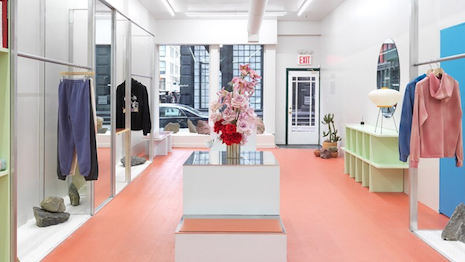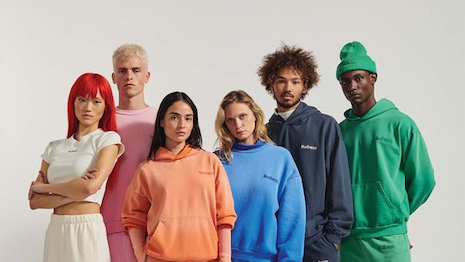Los Angeles-based label Madhappy’s emphasis on community and authenticity has endeared the streetwear and lifestyle brand to discerning Gen Z shoppers.
During a keynote session at the Vogue Business and Klarna Gen Z Forum on Jan. 27, Madhappy cofounder Peiman Raf discussed how the brand how has differentiated itself with a focus on optimism and mental health. The brand’s success has captured the attention of both shoppers and investors.
“In 2017, mental health was not in the news like it is today,” Mr. Raf said. “But I think the younger generation had always been on the pulse, wanting to talk about it being more open and seeing it as part of daily life.”
Community building
Although Madhappy began as a fashion label when it introduced its first hoodies, crewnecks and sweatpants in 2017, it has considered itself to be more of a lifestyle brand.
According to Mr. Raf, Madhappy looks to brands such as Nike and Patagonia as inspiration with the hopes of doing the same for mental health as they did for physical health and sustainability, respectively.
 Madhappy established a dedicated following with biweekly limited drops and pop-up shops. Image credit: Madhappy
Madhappy established a dedicated following with biweekly limited drops and pop-up shops. Image credit: Madhappy
“We thought around this concept of ‘mad happy’ we could create a brand more focused on optimism, more focused on positivity, and that could really have an impact,” Mr. Raf said. “And I think from very early on, I saw no one, no brands really talking about mental health.
“And so that became our thing pretty early on and we didn’t even really know what that meant at the beginning,” he said. “But I think that’s really evolved in many ways – but it still does come back to that core ethos around the name, Madhappy, and around the feeling of optimism that we felt like was lacking in a lot of brands.”
Since its early days, Madhappy has emphasized physical retail through pop-ups even as a digitally native brand.
These pop-ups served as an opportunity for community building through panels, block parties and other events. Mr. Raf also cited the differences in interactions through physical retail compared to online channels.
“The apparel, the retail and the event-types of activities were very, very ingrained in what we’re doing since day one and so we continue to push that forward,” Mr. Raf said. “That’s a huge, huge part of what we’re doing and we’re happy, hopefully as we come out of COVID, to continue doing more physical activations.”
The brand has further emphasized accessibility with the launch of its Local Optimist mental health resources hub and The Madhappy Podcast, hosted by Mr. Raf and cofounder Mason Spector. Other initiatives include the Local Optimist hotline, a non-crisis text support line.
“I think we’ve tried to be very authentic to who our brand is, and not try to be any other brands,” Mr. Raf said. “And I think the younger generation especially can tell if you’re trying to be something you’re not, or if you’re being fake and those sorts of things.
“Of course, sometimes it’s hard to reconcile everything we’re talking about on the mental health side, and how exactly we release product and some of the stuff does sell out and isn’t accessible for everyone,” he said. “It’s always that balance of us trying to put the brand in the best position to be successful, to make the biggest impact that it can while understanding that the consumer is going to evolve and grow.”
Looking back and looking ahead
In the near future, Madhappy is hoping to expand into new regions outside of the U.S.
This growth is possible in part because of the support of French luxury conglomerate LVMH Moët Hennessy Louis Vuitton, which invested in Madhappy in 2019 through LVMH Luxury Ventures. LVMH was attracted to Madhappy for many of the same reasons as shoppers, including its focus on mental health conversations and offerings for both female and male consumers (see story).
“We will be open to feedback, see how that market is a little bit different than ours and hopefully make those adjustments and keep building the brand,” Mr. Raf said.
{"ct":"ku2BA5I9GSDcma0VXCEE\/ZVMQBdGDzPw\/PUa07oyzybW51UfESSeOHlUZAfVHFoe7BCuRJlipheIo2S4Lrxdhg6ap8fAs4GBEKk3E84EJx8wUCOFbXFVTUiH3S3gdu1JpTiuN\/eeX3RULAN\/s\/L92\/MaCUifl3AqZQV1+hkJOpMF8iiFCbK5jIDjuloDWDtocjkJLq\/lMjyA1RPRwO8hQ4gpRp6YqgYNe5mYCwjNwOgmu5Uc\/CQDuaNSwNiEW5nHJHBF3yfF2\/7xKa6ZFHcI6GJNMscfjm+1eMgi2W65YKtFzRKRi\/fTS7BnFIaNeTlJyRXt3iceciotSZX04ETU23XclVXU\/hkMM+nzDGVywts81SYXq01OTs83yU\/80dzkwWwVFoHDgCbW4rVNos3QM+J1qU5G0r21UFM9xrenXsPJ16NTzsOnsYUcEQmpFgn1pRWu5VWxNOrA9u+HVSfS1Lff9Qynj5azQ55vHicYQtTYDXYxf0qTcQZlAjQ3IHSG+\/ESLMB4haRPwgHYFCSjD7FBk3kZd6kbKpyBWG+XcSuEL44TcIBcTIWrUw7aa1nm020jx32H9auJCaTRc3jUbmPd3eGeMeI5xApTt5d9QgtD7DtxcRiVKVISyWgOwMpR8J06LEwgcJrtJvXeA7wK6OEG3d2Q2xlImDblxsKkr4mqlx4rNv1YapWoeaZ6Umxq+xar8Ud9T6tbriTGld40Jxp11sZ\/uw5oA7rRALLWhLkmaJuTNada2Mt\/Y4oUUnhWcZnuTu6yvCVwoq1pN\/kDLzKgZMR6hf86869eWADbX+e+XogOZdNuXlf9ZI0Otwm4nUOLjpuH\/aiWG0G2MZ1+qmmrmHVmQa0pw++pCUMxPIe+\/oflitvolwsxxAfk0lFN0g2Ci+LqFzpDbqFLYBRULqX0uHmtdb070DQ++rhtqftOVYFn8jsU91mFtSxXZLa1D0ISL5v6zSLjl9CxacVKHlCHuN42zs06x+26yQHgZN2DV6YlZ5MIznoJY4mHodZzRvhfuJf45cDBVjHgufN9ELJUly8xe4i8yeg3etEBnH1cHSBgSjxNpLpTD9UPB3lpLWw4uL45FhexoY8VYyvrria7JkJLIIOoNQw7CUlAlgYt\/tjwcJgxwegpbaOijCBO2n6TaLRgRctp6jiLqCB\/59kYRtQfJfuRHrHs6pFbNzM7esh3MF7IZt1LdsyiaJHt3L+8iOynFD5rBHCEXHlDMWFpurmZh1b557Yuo2l2W5n8K5DZyPNWHEVvUxb4FhzcQwNNmEcu\/Yp3TO4VWDH3HR\/y1axd+OfXVcHNbdCTGLAvougjxyBDlLfv2+HAkq70J6X7C7f8JNwni64BX7HW84d6gNdfXIbqcISLPFo3dIbbXucBd5S24DMhjfpV8tCJVKQqxcO9PTgY6BSr49sKt8WfsSlxvoahSQFkXhYx1jOXY+pRs5ef5YXOPt\/TPRnNFVttAabwGiJRP2Usa16pMkaCyxAsq3cljqlKTexJOqdVizQpZDfEA+Nc7N0f2YjQlCkDFIHT1yCVMHSL2lglVtULuJKTa1wHEkOYHA8FaY4uKxL4UZld94CwIK3wodE8RBNiEHCSuMpkRhbdQsWfY9SwpZTTmDEwrlv83\/\/i9RhHMxIBwF5AA1FUXhlOvVuhmMPLrdJr6jhsrDqHPiJ0oO2umhlinoYvNLy4pDJ0MKk8yt1AnvUUhoif\/FDjZGHO2VGn9Tl9sbVIbL9LrMEJrJ2+qpPHadm20aGCswVl5yXn8fj0cHl7HroEH1c5xbATWqtt4hdzJT9Qzf3SZbcGoDrRXybT9Yih1plIbEUd42FLmIBnPMZB4UH\/gMunCWjjHIjqipDQUggMHN7+dAH2rKf8LkgzwxevO7jRhRi7C3V9hV3xwEvg8VEoGtN6AbLBoEDmJi8F0F9veHOpPuo9v9yJLyBSJlIrMOsyp8ytVzYwnzz8r+qJgSl9VR6vp54\/EGZ66DFpmcBtXMKgi4NHS2ZWGFNV647o0A94IklY9IfqAL0Wq0\/6ONG6KEfTlGR5TTZX6+rptwwN8KnWn5xC4+gMDCFIOqzSXMUMdOb+S8an3OTBHHz5qy11riE6anBE6LSP03kqqSLqTDkfgT\/ABmMb+Ul62hr0UVAbIVGMTOkcbU1ztj1pW0A2ZtIrZrbpADSb\/Vc96j8+CaxYxr2G5snyzbQrtqw9E8amYuOqhULpNL14Sz0LUalIZT1ETIT5Gc2V33Kc0H+NqNLpJPa6XL17wo+X+RtiYK1GCOPOpGr42cB5ZWN4FB6HmVoQFDrKwmES8\/4rzYHEy2otnSWGEVOA7zTaQ7TTDq4WUkASApEzNg4mR3szDBW9drYGZHv9bp9IcpkfEmM8tK70qvXft6cH6TmE7ql7\/jVzS3ytW22\/t0OnDMo2NmkXQuyxhiRRoTXXhptPRq\/4kN9eXrOTap4SD\/0TbKyvdfAj01yssLNmER1O8s4rA3NTIi9qjB\/tic9OGZtg5xH1BYepy4MHl1hF+3u9MQHt7skbmQTNPk6fuawbJ6tfSjD70gx9T\/LKipynpcOnkI0aBoeOSixMjdnyPGbu0rrZnqBF5lRkoSI9odOlQBnFSigbjrNVADs+WsrrjG7R\/\/jwr9XpCqytsNTzkmZg65FYjBuv\/i7HhvxTJ7i37lbJmYfueozsm38eicVneCUYvCEcAdzA7M2h1grFeXAZedTnWW3\/YuYR7JXDVN8v9u85aOWYpJLJq4LoRyjfHI\/Rn6\/dGrQQOV\/vcvo\/MkcCzRk1rIG2DStN3rh5wvQskl\/jzR+6iORUotubB1SOoSjgRBoQl+ct4TwPm8BRSuFcIIBwRRW6vfTBGeyUin1LJZoQaf8KKGc1ofaV6i2QIfIVNvF0MIIWORDKFL8Kdo86DFt33QhXWRniEZFRS7MrZvopzt8VZ5kXlp9V+ur4FaOYcEOw9E4XBFTSox\/0\/sdIPlBDFZCUdbrhFMpr6HtMdHt2PFLgHwCkjs7L3U2PnzOlTO82AeiJ5XcOr\/\/SYbE1ki4ls7oMkd62hUNTVHOzubwwgWpLC2r3wNLqbB9OmhgZSiJyQGrC7dRCpcWLPQ8bLgUnAhfFJHOqLYMLVGN\/uBygzQTj5yzb3cA8WcNemAT93A+6hoK5foxsEdXENfPuYNeckruxjcVsoPbpHedbvsEQgsVSpSBkloQtZmdX+msKYcg5qNLVxXKm0zyR5N97btuHuOcbNjtZgpNEeTUqOHpvyRuJPqoaeo2Qh1spCNOJ3JUIsTJUvg8NOpj6+K5tuNHnUHZSCK+6yaPUhC76jrhbB07UL12RvpohMLkq2PxrOj0qvh9xJbTvPfXCPoYNFu\/gl5TuTM9Erf4q80Qh0lxbOepinjupD2MxCgWavh2ETZNuqGOgtxCwKXfOwu8B\/A11pHhl17U09wDr5tYISvacHESR3jSClFFCvGwq39lK7UwlDpSffsTV6dxZS0UKa++fcY7MayUHm2fhbG0dhEKB\/qRiWpnW8NhKmn777DoztOuCKq6REVKI0tzNZ5vySQbloUZA15WNLB7d1ndNZAlIWcGS8vJbTIVVDhQwZBFtowwCCYIF3sgjXXzF3Bdn5lmZ6moAJ54YMDObYrSjet8qv6b09VluK6pZBZ\/VqMTaJi+M8MY8KIwx1js8r7f7u9uRbnixa8MXHgC\/kXvxrTf+NjTvhWAj3KrkEEI7StumTh2udyL5lcjZlBoIj62OUOAmZ69RqzpMZL8Q5SgSh6caAaHpIHvDkYZpHvZq\/r7hDotsn4WdXz5WqRjPkMgxvLYDolq9AMdu7GkCaHXnYlsroNNz39QtFFNcek9IRQFhENDfpMqC8+FfsDgCzCSQbhzEziS+ZMfNiIiHzhXmjlqpXNZmFFXePoKon4WQOQv\/IZhYJ9gzq2Mkb1gg5lCvE9mGiw2fAbEDd9EdnCzl\/XLHBHyof3Tk3\/YWz2\/xEPds4eJQ9mmG1LK\/4CQSsgyUeRuLqtKsjSNdrHSIrYTKAsgzOwCtEpIM\/PADAzJ4WNwmNnvfMOISZ62vJdox7fgaemVXDfm5o0KfadU132lFe5RLdiVLyIyGr0mAJ3wqgoCFmF2Vb6g3E2jjm2TeOFDUrk878UyVuw+UVf339XOLxRTzDyWTxPCVuXzmp2QlO\/Ipjzlb9wo5Poh6upKSti6jNQ4RqQ8GEspdpvAqV5U8YHToY6vNyc4ZyKjoMRKSoKT9tH6PVXfOUKsBkAT43EOBAco9SxB4chuqQ7hInI688YfOliucWtZC6vKcL0hFvAlWcZdzhVIUkMhoUDmrGmVIU+a06jkGY9Q3amfO+FtRLC7FYvN22TIc+hgnwIASGs+jqOC9hQJ5QCo74iERj73eDboLW\/w1YkLFnC4yvRz7OmfJivIbEkGjKExkyqm3PZ2Qnu6b6F1sqicm1wHuAXdlkImlcWk\/gQx55spwhVhI+59lxFqwMjPBPXH+btr259MSTlSxiSZD9lYmp0vn0HXIkWc4ojF9ygiUIWXrG29zUydjSk+3IeMxMZtl2U1FcasdS7LHW6FSlECMVyJwVUDXyOmeto7zWGbh1oVVSD7vGlSkiQ5ebOrrW7zIWACkaGmNrC\/B5QMOr\/BqSRBhMTlXLPUpzrdw72OtGIbtKuOVZ+6hKQNyHe\/H5S6dB4FNs0zn7vBImZIYSN\/0diG7FzlxzTupwuwGEtUD7LnJb+zi++zowjf2IpxGPSS4NpnW3KrmKLOmOQxm2gAw1GI6vBjkdbgu1ZDcvZ84DR+YSL\/JMNbVsVM4HkVmeQZox5qHnZLi\/uP6EEbCzJ\/bOmqPeD5PR2J3+Bzo0dzeqaxcJLpbxNecJgXzcE2LrmI1OBuz96cHshAo0D1qhKkem+uvSK6djKH57xu97cUqHNPccltKZUV2Edqwg7lGDvz\/eY+7heoufbhewkBa1COBrx6090Ne+Ckq28zzjXNsqXx4SBTeBRK1zisKg6wSJjX1SL8f2SgDqu7ssdHm7WgRRxHOOJwSaPhkK1Ww++Ag9AG46G90Lyw9V3lXfs5\/BANS3WZWhnn8XNRyWv3C+P54dahgkUM7uUmAqkEu7Gsz5JmeaRwaUsJAZsdlRvt9RnO+S9T\/BKGwlHb6exysY8FY5boKTLdDtS4yKnJtJ0EtXwEsZqAhPdHbm1IXuegq84OCWtYeZ9FDYsV30NClUUmJt3RRNG7qqcIA9jic\/BuSTIL\/hirYReeWnyGd4iJixHP5vVWaucw1Cw58G91YsVt6WZ\/fsbHcp8lKTfebjiaUqZtJ9sIGE3DfQKkhRa7gFZ8lAmIrYfA+oAQZPE8pfqxAEq4XTiGC1MQnq4xp4cINDImmPWO\/LOpIcYiTB2tRR3PHWlHywp71fXbuDduXZz0sDjr3qL\/TVkHn+ERH9Xcz09242I4s2xwF6xqkMilV5AQNs1Dg73okTBKAXhcfXrg+DrPjUNHfHPm\/ZaU\/bcQjNR9xJfxH3pB8XWDpDU77IQywm+o+e0MbOHsB5X8bP7Mt2DhchCi\/1N280KJegqECYfpIph\/nov\/pfW8wfzY+svr9q\/v++v2nZHrMPTZLiCauNxonzFxPjYIAeuxnOxDCEB9DqU0PWL7soOe9hazQHfq1YH4o130njsuREq0YBtH4VYefU60uByhfq\/34yC7m9N9Ql+otljY8p\/yPavo65oLGi\/uLG0I3LcEiNsl00ZlPiA9\/oNX7zfkLhVqOrQkBShLC2wlTw3rnq9jmYsFiF7ybjV6olGfMi2KGM5CouDv+zO5+rM4RH0PAFqqi37LSG+Wn8juF3TNop570VnxbyqvudBqlWwXBu0WEtH5XtShXW0XCYlgYL9el9ztgUkEnTWaSsEPXaRP3AJgBp8o1EnyLSjwoyYL+w9tUeEGpdNy4z2C5OuUGes1RUPxc00nkzK1uIgTTachA0VmoX6\/WWPM3Aq4cJVf4GKFDIUArGbu2LLEwxwyeESHmKcE8Gq9zI02vfpk+tt39vmg5h8RE0rKECcQxBZQ1NOHU2iNiYSkjAW\/KgxE3Aig\/w8Z4ErFeqe1zjZ72ldPY6qamRfgKAikkV43ohQJg8vt9iYA0qCC+Hw0i387oVApoujUoTw6I\/fa8\/0XdYlwVxNQbEMu7QTnMM0Mhs8WcTfu5f3WAiuc\/VjOhckR1TgBpfhjzwP\/BJ5\/YT4wU4v02KLurZ0hmcFB1mHV+xXN6o2bQYiT4lOp+5vK0JEDVapbx9f53H2jvSv0W0sOT0Y5SICgMuTknNvBYN\/uxiP40gZ+BQx35h5shcTkdqLCV1OPjVtXEbkSO9I90I5OXoUZ4\/bq1\/a6AdRNYZWOeffbGYmqfhmgp0yH1AqOwvBZM0kotqGGDlzkEDi4WqF4jTYL8uZwCld4TxP9hq3Ri8VqmlVGOyrAWiCx8LCw2M40j6nTQwSnZeGBC1Nx3c6+yuRhmxqCVQMffzHJQqusBv\/KbSA6j34SaY1B3O1zm1Q7MGaQhCNn1iKQz0i8MJn2XsfcGYWeWOrHik2vhJbIhuSkTvCCLV2mxp56LInCS\/m\/rzYQne\/4t4alEN669RBxrRZgspz8NiyfAQodXOoXOw4zMMYBm\/wyaeCsTLENwwblMLSL70DBIUnUGYE9akzvfiMIAaoz9f1i8ih1OiWQF5RLVrCUK7DGLTe9GeL0IijWhyt4p0dgruWVQgVoLoi6nvh2J8eqUA1ce19HURaD1hC+dnHr\/DySaU3QpZa34kGIm8J3MDZ+hEa+Lawtn86sIqjhQtqtgxqZ2dZy\/9oBbAtEqZEyY9z6aVulHwZgpoooy2J+9DKKhHr5O3F4=","iv":"b34e56f32c9695109982ede200cb6130","s":"d8b7f5773f30c059"}

 LVMH Luxury Ventures has backed Madhappy since 2019. Image credit: Madhappy
LVMH Luxury Ventures has backed Madhappy since 2019. Image credit: Madhappy  Madhappy established a dedicated following with biweekly limited drops and pop-up shops. Image credit: Madhappy
Madhappy established a dedicated following with biweekly limited drops and pop-up shops. Image credit: Madhappy